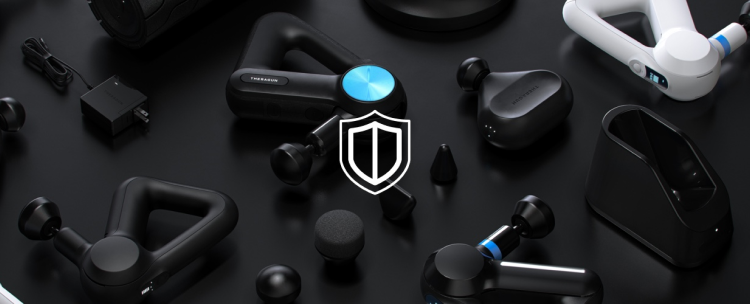Authors: Therabody Scientists: Tim Roberts, MSc; Kyle Silvey, PhD, CSCS; Michelle Darian, MS, MPH, RD, LDN
Women dominate most medical diagnoses related to chronic pain: migraines, rheumatoid arthritis, endometriosis, pelvic pain syndrome, and irritable bowel syndrome, to name a few. [1] So why can getting a swift diagnosis and an effective treatment plan for these conditions take years? Quite frankly, clinical research and medical practice are based on the male default.
Men have historically been the primary participants in scientific studies to understand medical conditions — from deciphering disease risk factors, symptoms, and even treatment medications. For decades, it was (wrongfully) assumed that outcomes from medical studies in men would universally apply to women. While science and vocal healthcare practitioners and women have raised awareness of these sex and gender discrepancies, the bias runs deep.
Here at Therabody®, we aim to bring cutting-edge wellness technology to everybody. That means bringing solutions that specifically target women’s pain (and continuing to study and innovate on this technology).
Let’s take a deeper dive into the current state of things, why there’s urgency for change, and our vision for the future of women’s pain management.
Chronic Pain Experienced by Women
Numerous diseases have only one reported symptom: pain. And many of these conditions are ones that disproportionately impact women.
Of course, there are pain-based conditions that only affect women.
Researchers and practitioners are trying to understand why the prevalence of these conditions differs between men and women. Here’s what we know so far.
How Women’s Pain Differs from Men’s
The way pain is perceived, expressed, and coped with can differ by both sex and gender.
- Gender: From a young age, boys and girls are treated differently when it comes to pain. Many societies teach boys to be tough and tolerate pain (and painful experiences). They don’t always vocalize their pain — possibly staying silent until a situation becomes unbearable. On the other hand, research shows girls are often encouraged to verbalize discomfort. And as adults, that translates to discussing their pain more openly with a support system or healthcare professionals. However, the (archaic) societal belief that women are physically more sensitive than men has influenced healthcare providers to take women’s pain less seriously than a man’s and to even doubt concerns. [1]
- Sex: Of course, there are also biological differences between males and females. The body has sex-specific pain mediators, and research shows that a female’s pain response changes with the menstrual cycle, pregnancy, and contraceptive use. So, the fluctuations of hormones in women can influence their pain. [1] There are also neurological differences between males and females. Studies indicate that women have a higher density of nerve endings (and pain receptors than men). [7, 8]
Sex and gender do not solely account for the differences in men’s and women’s pain. There are still a lot of unknowns when it comes to pain, in part because women’s health research is ages behind men.
Women Are Historically Underrepresented in Clinical Studies
Women have been historically underrepresented, or excluded altogether, in clinical trials. From 1977 to 1993, the Food and Drug Administration banned women of childbearing age from participating in early clinical trials after thousands of pregnant women were given the sedative thalidomide, which led to severe birth defects. [9] Women were then classified as a vulnerable population.
“The creation of the National Institute of Health Office of Women’s Research (in 1990) began to shed light on serious knowledge gaps in women’s health," says Dr. Pamela Peeke, Therabody Scientific Advisory Board Member.
And it wasn’t even until 2014 that the NIH required that sex be a biological variable in all studies — meaning researchers had to either include women or state why they didn’t. [10, 11] Unfortunately, reasons such as women have a menstrual cycle are enough to exclude an entire sex from a study.
While there is a lack of data on various health conditions in women, research and medication data in men have historically been extrapolated to women. For example, conditions like heart attacks and migraines present differently in men and women, leading women to be misdiagnosed since they don’t always present with textbook (male-specific) symptoms. [12]
“One of the biggest issues in women’s health in physical therapy is we need to learn more about how treatments affect women. Women are underrepresented in research studies on musculoskeletal health and physical therapy, says Dr. Dan Giordano, Therabody Scientific Advisory Board Member. “Because of this, their symptoms are dismissed, misdiagnosed, or not adequately addressed."
As an example, Dr. Giordano shares that pelvic floor dysfunctions are often misdiagnosed as hip issues in the physical therapy world — even with an array of symptoms (like urinary incontinence and pain with sexual intercourse) present.
“Women are not little men. Women are distinctly unique and highly complex," asserts Dr. Peeke. Complexity isn’t a vulnerability but rather a set of factors that should be accounted for.
Women’s Experiences Seeking Medical Care for Chronic Pain
When science doesn’t recognize women-specific symptoms and problems, practitioners aren’t trained to identify them. Pair that with gender bias towards women, and it’s a recipe for a poor patient-practitioner relationship.
Women with pain conditions report not being heard, understood, or taken seriously by healthcare professionals — specifically as it relates to their “invisible" pain. This has been shown to lead to distress, which then perpetuates a practitioner’s belief that the pain isn’t physical; it’s psychological. [1]
The Economic Impact of Women’s Pain
Seeking medical treatment for this pain also costs women (and society) a lot of money. A 2021 systematic review of women with chronic pelvic pain calculated the annual cost of this condition to be between $16,970 and $20,898, which includes healthcare, prescriptions, lost wages from missed days, or reduced productivity, among others. [13] Not to mention the cost associated with women who are primary caregivers. [1]
Technological Advances in Women’s Pain
Just as the medical field has a long way to go in terms of gender and sex equality in clinical practice, so too does technology. Therabody is working to change the future of health and wellness globally. And this starts with acknowledging inequities and driving solutions that are tailored to women.
“The entire socioeconomic ecosystem has begun to pivot toward honoring women of all ages as consumers, patients, and advocates for their own health and wellness," says Dr. Peeke. “Technology plays a critical role in supporting this."
Leading the way in the health technology industry, Therabody is currently conducting research in partnership with academic institutions that study women’s pain and solutions for it. The muscle-stimulating PowerDot ® has a Period Pain Relief program to help relieve cramping and period pain (by up to 25%). [14] Broadened research of PowerDot and additional technological solutions are on the horizon.
“The most exciting part of science is extracting the key assets of a discovery and designing technology to actualize benefits in people," says Dr. Peeke. “From the research lab to creative development, to endless beta testing and then to execution in real-time…it’s such a joyful moment when a scientist can see that innovative technology has improved someone’s quality of life. That’s what we in science live for."
And that’s the kind of research Therabody is working to lead.
Key Takeaways
- Women experience chronic pain conditions at much higher rates than men.
- It’s challenging for women to navigate the medical system in pain, as doctors can be dismissive of their symptoms or misdiagnose them altogether.
- Part of that misdiagnosis could be from the lack of research available on female-specific health outcomes or presentations of diseases after being excluded from clinical trials for decades.
- Wellness technology also plays a game of catch-up. Here at Therabody, we are partnering with scientists and top institutions to deliver technology to help fill this gap.
References:
- https://www.ncbi.nlm.nih.gov/pmc/articles/PMC5845507/
- https://www.ncbi.nlm.nih.gov/pmc/articles/PMC8119594/
- https://www.ncbi.nlm.nih.gov/pmc/articles/PMC6425926/
- https://www.ncbi.nlm.nih.gov/pmc/articles/PMC3972521/
- https://www.who.int/news-room/fact-sheets/detail/endometriosis
- https://www.ncbi.nlm.nih.gov/books/NBK285446/
- https://www.ncbi.nlm.nih.gov/pmc/articles/PMC7767267/
- https://www.ncbi.nlm.nih.gov/pmc/articles/PMC2745644/
- https://www.fda.gov/science-research/womens-health-research/gender-studies-product-development-historical-overview
- https://www.ncbi.nlm.nih.gov/pmc/articles/PMC8348944/
- https://orwh.od.nih.gov/e-learning/sex-as-biological-variable-primer
- https://www.ahajournals.org/doi/10.1161/circulationaha.117.031650
- https://pubmed.ncbi.nlm.nih.gov/34587539/
- https://pubmed.ncbi.nlm.nih.gov/28885348/







